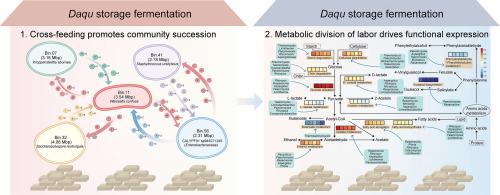代谢相互作用驱动浓味大曲微生物群落演替和功能表达
IF 13
1区 综合性期刊
Q1 MULTIDISCIPLINARY SCIENCES
引用次数: 0
摘要
农香星大曲是一种以小麦为原料的发酵发酵剂,用于白酒(中国传统的蒸馏酒)的生产,其在储存过程中的发酵过程直接影响其质量。然而,大曲储存过程中微生物演替和代谢的动态,特别是特定微生物对酶形成及其代谢相互作用的功能贡献尚不清楚。目的研究大曲贮藏过程中微生物群落结构、功能和酶活性的时间动态,重点研究其代谢相互作用,如交叉取食和代谢分工(MDOL)。方法采用宏基因组和元蛋白质组学分析方法,分析不同储存时间点的微生物分类群、功能基因和蛋白质表达。加权基因共表达网络分析(WGCNA)将基因模块与储存时间联系起来。构建基因组尺度的代谢模型(GEMs)来推断微生物之间的代谢相互作用网络。结果优势种为变曲霉、黑棘皮菌、小孢子根霉、delemar根霉、竹节根霉和白僵菌。总共鉴定出14,588个蛋白质组,包括6,801种富含碳水化合物、氨基酸和能量代谢的酶。葡萄糖苷酶活性主要来自于Rasamsonia、Thermoascus、Aspergillus、thermoyces和Paecilomyces。功能基因和酶在第1个月后急剧下降,在第3个月达到最低点,到第4个月部分回升。WGCNA鉴定出16个与储存相关的基因模块(最大r = 0.97,P < 0.01)。交叉取食模式主要存在于猪囊菌、猪囊菌、直叶糖多孢子菌和肠杆菌科。MDOL模型揭示了放线菌门、杆状菌门、子囊菌门和毛霉门在原料转化为风味化合物过程中的协同代谢作用。结论本研究结果有助于提高对大曲贮藏过程微生态动态的认识,为调节和优化大曲贮藏期间的发酵过程提供理论依据。本文章由计算机程序翻译,如有差异,请以英文原文为准。

Metabolic interactions drive microbial community succession and functional expression of Nongxiangxing (Strong-flavor) daqu
Introduction
Nongxiangxing daqu is a wheat-based fermentation starter used in the production of Baijiu (a traditional Chinese distilled spirit), whose fermentation process during storage directly affects its quality. However, the dynamics of microbial succession and metabolism during daqu storage, particularly the functional contributions of specific microorganisms to enzyme formation and their metabolic interactions, remain unclear.Objectives
This study aimed to investigate the temporal dynamics of microbial community structure, function, and enzymatic activity in daqu during storage, with a focus on metabolic interactions such as cross-feeding and metabolic division of labor (MDOL).Methods
Metagenomic and metaproteomic analyses were integrated to profile microbial taxa, functional genes, and protein expression across storage time points. Weighted gene co-expression network analysis (WGCNA) linked gene modules to storage time. Genome-scale metabolic models (GEMs) were constructed to infer metabolic interaction networks among microbes.Results
Paecilomyces variotii, Rasamsonia emersonii, Rhizopus microsporus, Rhizopus delemar, Kroppenstedtia eburnea, and Weissella confusa were dominant species. In total, 14,588 protein groups were identified, including 6,801 enzymes enriched in carbohydrate, amino acid, and energy metabolism. Glucosidase activity was primarily attributed to Rasamsonia, Thermoascus, Aspergillus, Thermomyces, and Paecilomyces. Functional genes and enzymes declined sharply after month 1, reached a nadir at month 3, and partially rebounded by month 4. WGCNA identified 16 gene modules associated with storage (maximum r = 0.97, P < 0.01). Cross-feeding patterns were identified among Weissella confusa, Kroppenstedtia eburnea, Saccharopolyspora rectivirgula, and Enterobacteriaceae. The MDOL model revealed cooperative metabolic roles among Actinomycetota, Bacillota, Ascomycota, and Mucoromycota in converting raw materials into flavor compounds.Conclusion
These findings improve the understanding of microecological dynamics during daqu storage and provide a theoretical basis for regulating and optimizing the fermentation process during the storage period.求助全文
通过发布文献求助,成功后即可免费获取论文全文。
去求助
来源期刊

Journal of Advanced Research
Multidisciplinary-Multidisciplinary
CiteScore
21.60
自引率
0.90%
发文量
280
审稿时长
12 weeks
期刊介绍:
Journal of Advanced Research (J. Adv. Res.) is an applied/natural sciences, peer-reviewed journal that focuses on interdisciplinary research. The journal aims to contribute to applied research and knowledge worldwide through the publication of original and high-quality research articles in the fields of Medicine, Pharmaceutical Sciences, Dentistry, Physical Therapy, Veterinary Medicine, and Basic and Biological Sciences.
The following abstracting and indexing services cover the Journal of Advanced Research: PubMed/Medline, Essential Science Indicators, Web of Science, Scopus, PubMed Central, PubMed, Science Citation Index Expanded, Directory of Open Access Journals (DOAJ), and INSPEC.
 求助内容:
求助内容: 应助结果提醒方式:
应助结果提醒方式:


